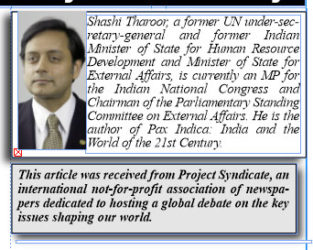
India’s latest round of elections included five state assemblies. Prime Minister Narendra Modi’s ruling Bharatiya Janata Party (BJP) prevailed in Uttar Pradesh – India’s largest state, which is home to more than 200 million people and has produced seven of 15 prime ministers – and in neighboring Uttarakhand. The main opposition party, the Indian National Congress, triumphed in the northwestern state of Punjab and won pluralities in Goa and Manipur (though the BJP formed governments in the latter two states anyway, by assembling coalitions to ensure legislative majorities).
It looks like a mixed result. But India’s national politics has long been skewed toward the Hindi-speaking northern heartland, and Uttar Pradesh has far more voters than the other four states combined. So the results have been hailed as a victory for the BJP, affirming Modi’s popularity and vindicating his leadership – including of the campaign itself.
Indeed, Modi personally commanded the campaign in Uttar Pradesh, whose fabled city of Varanasi he represents in parliament. With his attendance at multiple political events and addresses to innumerable campaign rallies, Modi staked his government’s image – and, some would say, his own reputation as prime minister – on the election.
The benefits extend beyond status. Victory in Uttar Pradesh was critical to enable Modi to take control of India’s Upper House, whose members are elected by state legislative assemblies. The latest election results also assure him the legislative numbers he needs to get his own candidates elected as India’s President in July and Vice-President in August.
But at what cost? One clear downside of India’s perennial electioneering is that prime ministers must frequently leave aside their role as leader of the country to act as leader of their party. Modi is a take-no-prisoners campaigner, who revels in punchy invective and freely launches partisan attacks at opponents (including me). There’s nothing statesmanlike about it, and yet it will happen again soon, with a fresh round of elections, including in Modi’s home state of Gujarat, due before the end of the year.
If there ever were need for yet another clinching argument for a presidential system in India, it is the spectacle of the head of government abandoning the responsibilities of that office every few months to go on the stump for their party. The parliamentary system has not merely outlived any good it could do India; it was never well suited to Indian conditions. In fact, it is responsible for many of our principal political ills.
Like the American revolutionaries two centuries ago, Indian nationalists fought for “the rights of Englishmen,” which they thought the replication of the Houses of Parliament would epitomize and guarantee. When former British Prime Minister Clement Attlee, as a member of a British constitutional commission, suggested the United States’ presidential system as a model for India, the country’s leaders “rejected it with great emphasis.” Attlee recalled, “I had the feeling that they thought I was offering them margarine instead of butter.”
But perhaps margarine might have suited India’s vegetarian tastes better. Indeed, while a parliamentary system can work in a small, largely homogenous country, in India’s large, diverse, and fractious polity, it has been messy, to say the least.
The system’s apologists point out that it has kept India together and given every citizen a stake in the country’s political destiny. But any form of genuine democracy would do that. The question is which form of democracy would also ensure effective performance, without allowing the government to be constantly distracted by petty politics. Perhaps the answer lies in the US or Latin American model, with a directly elected chief executive – a president, at the national level, and a governor, at the state level – serving a fixed term as both head of state and head of government.
A directly elected chief executive would not be vulnerable to the shifting sands of legislative support. They could appoint a cabinet of talented officials, confident in the stability of their tenure. Above all, they could devote their energies to governance, rather than just to politics. The relentless election cycle would come to an end.
In such a system, citizens would actually be voting for the individual they want in charge. The president could therefore claim to speak for a majority of Indians, rather than a majority of members of parliament. At the end of a fixed period of time – say, five years, as India’s MPs are currently accorded – the public would be able to judge their leader’s success at improving citizens’ lives, rather than at keeping a government in office.
Of course, in a sense, democracy is an end in itself. It is vital for India’s survival. Pluralism is a fundamental element of who we are, and we are proud of it. But few Indians are proud of the kind of politics our democracy has inflicted upon us. In order to confront the challenges and meet the needs of one-sixth of the world’s population, India’s leaders must operate within a democracy that enables, rather than hampers, governance. Only then can they deliver progress to the people they represent.
A presidential system would do just that. It would enable leaders to focus on representing the people, instead of on staying in power. With a more expansive and predictable election cycle, India’s leaders would be able to move beyond the unpleasant business of political contention, and settle down to governance. In that shift in focus lies a presidential system’s ultimate vindication. Copyright Project Syndicate 2017

